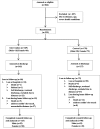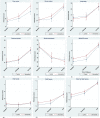Effect of play-based family-centered psychomotor/psychosocial stimulation on the development of severely acutely malnourished children under six in a low-income setting: a randomized controlled trial
- PMID: 31521161
- PMCID: PMC6744679
- DOI: 10.1186/s12887-019-1696-z
Effect of play-based family-centered psychomotor/psychosocial stimulation on the development of severely acutely malnourished children under six in a low-income setting: a randomized controlled trial
Abstract
Background: The World Health Organization (WHO) recommends incorporating psychosocial stimulation into the management of severe acute malnutrition (SAM). However, there is little evidence about the effectiveness of these interventions for SAM children, particularly when serious food shortages and lack of a balanced diet prevail. The objective of this study was to examine whether family-based psychomotor/psychosocial stimulation in a low-income setting improves the development, linear growth, and nutritional outcomes in children with SAM.
Method: Children with SAM (N = 339) admitted for treatment to the Jimma University Specialized Hospital, Ethiopia, were randomized to a control (n = 170) or intervention (n = 169) group. Both groups received routine medical care and nutritional treatment at the hospital. The intervention group additionally received play-based psychomotor/psychosocial stimulation during their hospital stay, and at home for 6 months after being discharged from hospital. The fine motor (FM) and gross motor (GM) functions, language (LA) and personal-social (PS) skills of the children were assessed using adapted Denver II, the social-emotional (SE) behavior was assessed using adapted Ages and Stages Questionnaires: Social-Emotional, and the linear growth and nutritional status were determined through anthropometric assessments. All outcomes were assessed before the intervention, upon discharge from hospital, and 6 months after discharge (as end-line). The overtime changes of these outcomes measured in both groups were compared using Generalized Estimating Equations.
Results: The intervention group improved significantly on GM during hospital follow-up by 0.88 points (p < 0.001, effect size = 0.26 SD), and on FM functions during the home follow-up by 1.09 points (p = 0.001, effect size = 0.22 SD). Both young and older children benefited similarly from the treatment. The intervention did not contribute significantly to linear growth and nutritional outcomes.
Conclusion: Psychomotor/psychosocial stimulation of SAM children enhances improvement in gross motor functions when combined with standard nutrient-rich diets, but it can enhance the fine motor functions even when such standard dietary care is not available.
Trial registration: The trial was retrospectively registered on 30 January 2017 at the US National Institute of Health (ClinicalTrials.gov) # NCT03036176 .
Conflict of interest statement
The authors declare that they have no competing interests.
Figures


Similar articles
-
The effect of psychosocial stimulation on the development, nutrition, and treatment outcomes of hospitalised children with severe acute malnutrition in Southern Ethiopia: a cluster randomised control trial: EPSoSAMC study.J Nutr Sci. 2025 Feb 11;14:e17. doi: 10.1017/jns.2024.94. eCollection 2025. J Nutr Sci. 2025. PMID: 39943936 Free PMC article. Clinical Trial.
-
Effects of home-based play-assisted stimulation on developmental performances of children living in extreme poverty: a randomized single-blind controlled trial.BMC Pediatr. 2018 Feb 5;18(1):29. doi: 10.1186/s12887-018-1023-0. BMC Pediatr. 2018. PMID: 29402258 Free PMC article. Clinical Trial.
-
Developmental performance of hospitalized severely acutely malnourished under-six children in low- income setting.BMC Pediatr. 2017 Nov 28;17(1):197. doi: 10.1186/s12887-017-0950-5. BMC Pediatr. 2017. PMID: 29179758 Free PMC article.
-
Ready-to-use therapeutic food (RUTF) for home-based nutritional rehabilitation of severe acute malnutrition in children from six months to five years of age.Cochrane Database Syst Rev. 2019 May 15;5(5):CD009000. doi: 10.1002/14651858.CD009000.pub3. Cochrane Database Syst Rev. 2019. PMID: 31090070 Free PMC article.
-
Community-based supplementary feeding for food insecure, vulnerable and malnourished populations - an overview of systematic reviews.Cochrane Database Syst Rev. 2018 Nov 9;11(11):CD010578. doi: 10.1002/14651858.CD010578.pub2. Cochrane Database Syst Rev. 2018. PMID: 30480324 Free PMC article.
Cited by
-
Parenting interventions to promote early child development in the first three years of life: A global systematic review and meta-analysis.PLoS Med. 2021 May 10;18(5):e1003602. doi: 10.1371/journal.pmed.1003602. eCollection 2021 May. PLoS Med. 2021. PMID: 33970913 Free PMC article.
-
Postdischarge interventions for children hospitalized with severe acute malnutrition: a systematic review and meta-analysis.Am J Clin Nutr. 2021 Mar 11;113(3):574-585. doi: 10.1093/ajcn/nqaa359. Am J Clin Nutr. 2021. PMID: 33517377 Free PMC article.
-
The effects of psychosocial stimulation on the development, growth, and treatment outcome of children with severe acute malnutrition age 6-59 months in southern Ethiopia: a parallel group cluster randomized control trial (EPSoSAMC study).BMC Public Health. 2019 Dec 2;19(1):1610. doi: 10.1186/s12889-019-7916-5. BMC Public Health. 2019. PMID: 31791303 Free PMC article.
-
Effect of parenting intervention through "Care for Child Development Guideline" on early child development and behaviors: a randomized controlled trial.BMC Pediatr. 2022 Dec 2;22(1):690. doi: 10.1186/s12887-022-03752-x. BMC Pediatr. 2022. PMID: 36461019 Free PMC article. Clinical Trial.
-
Analysis of Postdischarge Interventions for Children Treated for Moderate or Severe Wasting, Growth Faltering or Failure, or Edema: A Systematic Review.JAMA Netw Open. 2023 May 1;6(5):e2315077. doi: 10.1001/jamanetworkopen.2023.15077. JAMA Netw Open. 2023. PMID: 37223898 Free PMC article.
References
-
- WHO. World Health Statistics 2016: monitoring health for the SDGs, sustainable development goals. World Health Organization; 2016. https://apps.who.int/iris/handle/10665/206498.
-
- Central Statistical Agency [Ethiopia] 2016 . ETHIOPIA Demographic and Health Survey 2016. Addis Ababa and Rockville: CSA and ICF; 2016.
-
- Martorell R. Early child development: investing in our children’s future. 1997. Undernutrition during pregnancy and early childhood and its consequences for cognitive and behavioral development; pp. 39–83.
-
- Heaver R. Strengthening country commitment to human development: lessons from nutrition. Washington DC: The World Bank; 2005.
-
- Martorell R, Nguyen P. Nestlé Nutrition workshop series Pediatric program. Vevey; Philadelphia: Nestec; Lippincott Williams & Wilkins, c1999; 2010. Interrelationship between growth and development in low and middle income countries; pp. 99–121. - PubMed

